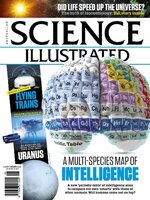Science Illustrated delivers natural science, break through discoveries and an understanding of the world for the entire family. Packed with stunning photography and in-depth editorial it’s a visually spectacular gateway to the world looking into the beginning of life to distant objects in the universe.
SUBSCRIBE & START SAVING NOW! • From as little as $39*
Science Illustrated
SPACE REMNANT
ICE BED
Cosmic collision created heart-shaped region on Pluto • Astronomers have recreated the violent event that may have produced the dwarf planet’s iconic heart-shaped accretion of nitrogen ice.
Is PTSD hereditary? • In a large meta-analysis, a US research team has discovered 43 genes which influence the development of PTSD.
Extinct snake longer than a Sydney bus • Indian palaeontologists have found evidence of what may have been the biggest snake in the world when it slithered the Earth 47 million years ago.
If life can prosper beneath the Atacama Desert, what about Mars? • Microbial life, including extremophile bacteria, thrives in the ground deep beneath the superdry Atacama Desert. If they can live there, could they also exist under similar conditions on Mars?
Sediments reveal events after the dinosaur meteor • An asteroid impact triggered the mass extinction that killed off the dinosaurs, but how exactly? Scientists may now have the answer.
Finding a ‘self-destruct’ button for cancer cells • Researchers may have found a crucial surface receptor on cancer cells which could provide a way into the heart of even solid tumours, opening them up to new treatments.
Are volcanic eruptions the same everywhere? • “Can volcanic eruptions happen on other planets? And are they similar to the phenomenon we know from Earth?”
Why do faeces smell? • “If I smell faeces, does that mean I have particles of faeces in my nose? What exactly makes faeces smell, and what is reaching my nose?”
THE DUEL • Atomic bomb vs hydrogen bomb
Why is heat so exhausting?
When did humans start wearing footwear? • “The Romans were known to wear leather sandals some 2000 years ago. Is that the oldest known human-made footwear?”
Which animal has the strongest teeth? • “I have heard that some animals that can bite through metal. Which animal has the strongest teeth out of all of them?”
Why are clouds flat underneath?
…you burn calories from just sitting on the couch?
What is the best position on a toilet? • “I heard that just sitting on a toilet isn’t the best way to achieve the right pressure in the bowels. Is that right?”
Get your knees up • If you don’t have the facilities for squat toileting, you can just improve the way you sit on the toilet in order to ease the passing. It is harder to defecate when sitting upright.
Do iodine tablets protect against radiation, and if so, how?
“Is hail always round? It doesn’t look round, close-up.” • How does hail form? What decides the shape of hailstones?
TO THE END OF THE UNIVERSE • What would happen if we got on a spacecraft and travelled at the speed of light towards the end of the universe? Scientists have introduced a hypothesis that illustrates the odd consequences of such a journey – and different ideas of where it might end.
Constant acceleration affects time • The spacecraft is constantly accelerating at 10 m/s2 and reaches the edge of the Solar System at incredible speed. Passing through the Milky Way towards our neighbouring Andromeda galaxy, its speed becomes so intense that the astronauts’ experience of time changes.
The universe outgrows us • Even when travelling close to the speed of light, our fictional spacecraft will never reach the most distant objects in the universe. The expansion of the...

 Issue 111
Issue 111
 Issue 110
Issue 110
 Issue 109
Issue 109
 Issue 108
Issue 108
 Issue 107
Issue 107
 Issue 106
Issue 106
 Issue 105
Issue 105
 Issue 104
Issue 104
 Issue 103
Issue 103
 Issue 102
Issue 102
 Issue 101
Issue 101
 Issue 100
Issue 100
 Issue 99
Issue 99
 Issue 98
Issue 98
 Issue 97
Issue 97
 Issue 96
Issue 96
 Issue 95
Issue 95
 Issue 94
Issue 94
 Issue 93
Issue 93
 Issue 92
Issue 92
 Issue 91
Issue 91
 Issue 90
Issue 90
 Issue 89
Issue 89
 Issue 88
Issue 88
